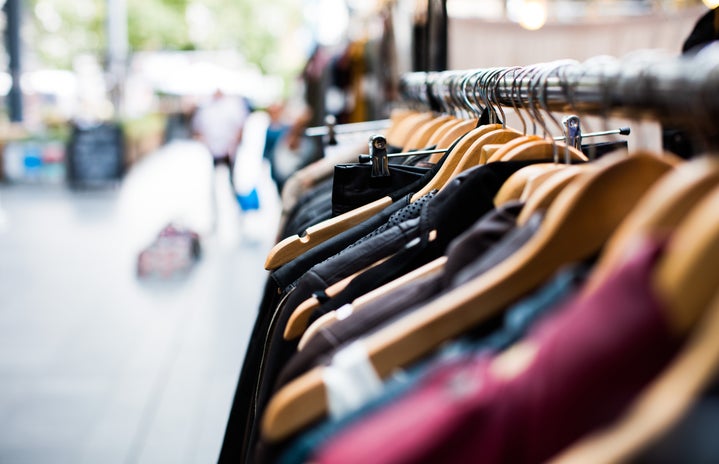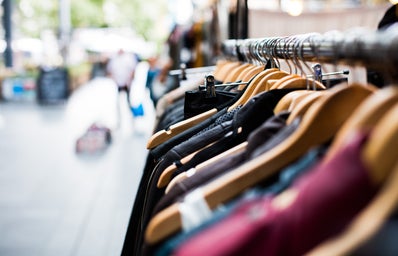“What are your favorite brands?” “Where do you shop?” “Have you seen the most recent trending clothes?” In a world of fashion trends at our fingertips and the ability to purchase any piece of clothing in a moment, it is important to stop and think about what we are buying. This semester, I am taking a class titled “The Psychology of the Climate Crisis” which looks at how we mentally process climate change and what we can do to combat the issue. I feel particularly drawn to the theme of sustainability through clothing, because I love fashion and the ability to express myself through a piece of clothing. When I go shopping, I am drawn to the sponsored advertisements of fast fashion brands (for example, Shein) because they are cheap, accessible, and “trendy.” However, is fast-fashion actually “cheaper” in the long run? Although it seems cheaper and more “chic” in the moment, it ultimately costs more because of its poor quality, ill-fit, and specific style tailoring to current trends. Today, I am going to give some great options to explore in-person and online shopping while also tackling the mindset we have towards the fast-fashion industry.
Before I discuss the alternatives to fast-fashion, we must change our mindset and attitudes on how we look at trends through social media and our own perceptions of ourselves. In today’s world, it is easy to feel as though you are behind or left out in the fashion realm because we are constantly consuming information on social media. Oftentimes, you find yourself wanting to comply with certain trends because it is what is expected of you and you want to recognize/identify yourself as a part of a group of people who are “stylish” and “well-dressed”. This can have us going down a loophole of how we are expected to dress or stay up-to-date, creating a strong echo chamber of the most recent fashion trends. As we fall into this echo chamber, we continue to believe that every fashionable person is constantly shopping and following trends, meaning that we experience confirmation bias, the bias in which we seek information that solidifies our current attitudes. How we are expected to dress is shaped by those around us, what we see online, and our need to fit in.
There is also a common belief that it is expensive to shop for clothing in an environmentally friendly way and that it is cheaper to get something from a fast fashion brand now than wait to find an item that you know you will enjoy later. We can all become a victim to this idea and this belief system is actually a result of present bias, which is the bias of valuing immediate awards and undervaluing long-term beliefs. For example, you may be tempted to purchase a trendy cutout top now from a website like Shein because you will be in style now instead of saving to purchase the dress you have been wanting for weeks. This occurs because there is no immediate benefit to waiting and it seems like this item overall costs more. I have had this mindset before and I feel like many others have as well. Upon further research, I have found that on average, clothing from fast fashion brands are only worn 7 to 10 times before being thrown away and costs those between the ages of 18 to 24 an average of $767 a year by buying from fast fashion. Although you may believe that you are saving money and gaining immediate benefits, you may experience the immediate benefit but unfortunately, will spend more money later trying to replace it.
I know this was a lot of information discussing the mindset behind this but now I will give you advice on how to stay in-style and shop in an environmentally-friendly way.
- Thrifting and Second-Hand Shopping
- Thrifting and second-hand shopping is great for the bank and can also be a fun activity. There is also a heavy thrift store presence within the City of Worcester and even on campus. HerCampus just did their own thrift store last week and next semester, we will have another one! Thrifting can not only allow for an affordable shopping experience, but also the chance to experiment with style and find very unique pieces of clothing. If you do not have access to thrift in-person, there are a ton of second-hand resellers online. Depop, Curtsey, and for those who want more designer brands, TheRealReal, exist and you can find just as trendy and cute pieces there as you would from fast-fashion brands. Personally, thrifting is my favorite way to shop because it is a fun activity to do with friends and feels like a scavenger hunt to find the perfect item while saving money.
- Capsule Wardrobe and Investment Pieces
- If you want to invest in specific high-quality items but feel like it is not very versatile for each season, you can try to build a capsule wardrobe. A capsule wardrobe is a closet that consists of basic clothing elements as a central element with more specific seasonal clothing as a layering element. For example, purchasing a cute top with a good pair of jeans can work well in the summer and for the winter, you can layer with a turtleneck, jacket, and scarf. There are many high-quality brands that do cost more but the wear you will get out of these items will surpass any item purchased from a fast-fashion brand. My friend, Scarlett loves shopping at J. Crew and actually has had this one J. Crew sweater from the time she was born (literally – it was her mother’s that has lasted over 20 years and is still in fantastic condition!).
- Undoing the Mindset
- The main way to shop for clothing sustainably is to change your mindset. This has been difficult for me as I always want to be in style and keep up with the latest trends. Ultimately, I found that sometimes, after a couple of weeks, I did not even like that trend that much nor was the clothing piece something I would have worn if it were not in style. I have started shopping against trends and most importantly, thinking before buying. I try my best to wait 2 weeks after seeing something online to see if I truly want it.
Climate Change and shopping culture is not a “your problem you must fix your behavior ordeal” but is an institutional issue. We as individuals are not the sole contributors but so are these businesses that choose to unethically produce low-quality and non-versatile items. They contribute to waste production without taking responsibility or making recyclable clothing materials. Climate change has become highly political in the U.S. but honestly, it is beyond party and involves effort from everyone as a whole. So, next time you go to purchase some clothes, try out different second-hand websites or environmentally-friendly brands, reflect on how much you want that item, and don’t be afraid to experiment with your own style. Now you can save money and better the environment all the while doing it in style.


